Easy Sourdough Starter
This Easy Sourdough Starter recipe creates gorgeously fluffy homemade products such as Sourdough Baguettes. Included are simple step by step instructions on how to start, feed and Maintain Sourdough Starter that is perfect for beginners.
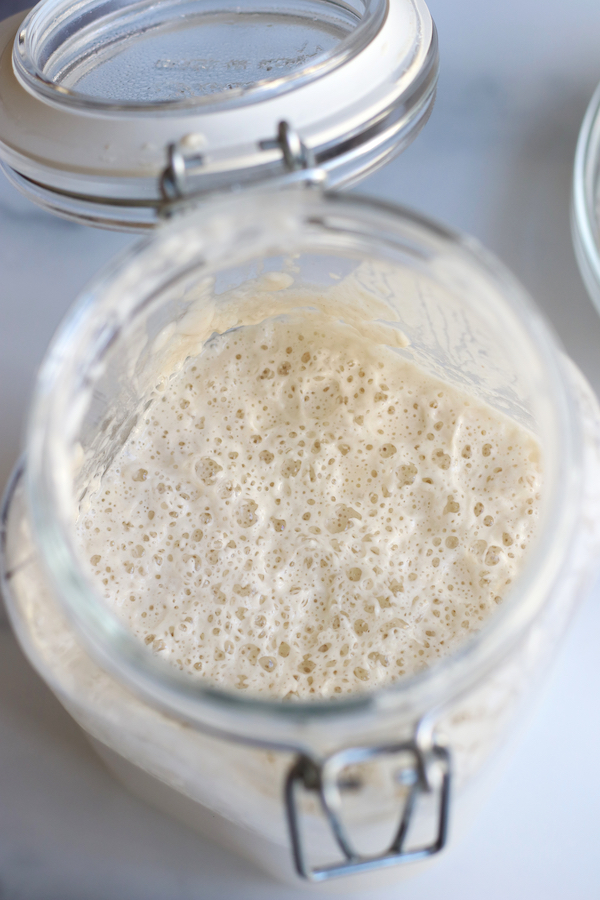
This post may contain affiliate links which I earn a small portion in sales if a purchase is made. Rest assured though, it is never at any additional cost to you.
What is Sourdough Starter
Very simply, sourdough starter is a fermented mixture of two ingredients, water and flour. Wild yeast found in flour flourishes when added to water and is allowed to rest in between feedings. This approach is the old fashioned way of making bread that has been done for centuries. It does require more time than active-dry or instant yeast but produces exceptional taste and textured baked goods.
Tools Needed
In addittion to the flour and water a few tools are needed to make your own from scratch Sourdough Starter.
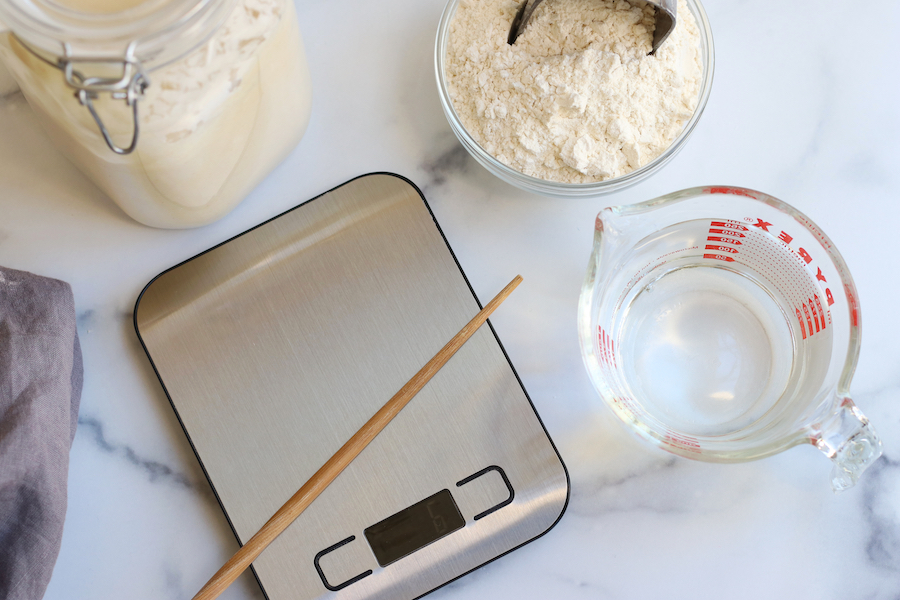
- Kitchen Scale- It is highly encouraged to use a kitchen scale to weigh the flour and water in equals parts to achieve the best results. This is the scale shown in the picture above. However, my next kitchen scale will be a little larger to accommodate the large bowl needed to make sourdough bread.
- Chopsticks– This makes stirring the starter in a glass jar much easier.
- Glass Measuring Cup– Makes for easy pouring of water.
- Scoop or Spoon– Helps with the addittion of flour.
- Medium Sized Glass Bowl– The first few days of a starters life is easier done in a medium size glass bowl.
- Plastic Wrap or Reusable Food Wraps– For the first few days of the starters life.
- Glass Jar (see below)
Sourdough Starter Container
The type of glass jar needed will depend on which type of flour you use to make your starter and how rapidly your starter ferments. This is the jar seen in the photo below and it works beautifully when using white all-purpose flour. Please see section directly below (White Flour vs Wheat Flour) for more explanation.

Best Flour for Sourdough Success
For the best sourdough starter, you need flour you can trust. Buying directly from King Arthur Flour means guaranteed freshness, expert-tested quality, and no risk of warehouse mishandling. Plus, you’ll find exclusive products, better stock availability, and support an employee-owned company dedicated to bakers. Skip the third-party markups and get the best right from the source. You and your sourdough deserve it! (affiliate)
White Flour vs Wheat Flour
The type of flour used will have a great influence on how your Stater ferments and the final product that you make with it. However, it is most important to not choose bleached flour as this will impede the fermentation.
All-Purpose White Flour
I adore sourdough bread that bites me back when I eat it. In other words, extra sour with a tang. However, my husband HATES that kind of bread. That is why I use all-purpose white flour for my Starter.
This type of flour yields breads that are very much like a crusty Italian loaf that he and I both go crazy for. Additionally, I use the Starter from this type of flour for making baguettes that then make incredible Homemade Breadcrumbs and croutons. The final products are never overly sour.
Wheat or Rye Flour
Wheat and rye flour has more naturally occurring wild yeast. Because of this, the starter made from these types of flours will ferment faster and with more intensity. It is very important to keep a closer eye on Starters made from these flours and to use a glass jar that has a lid that is looser or can be left slightly open. The reason for this, a tight fitting lid could be a recipe for an exploding jar.
In conclusion, wheat and rye flours will make much stronger sourdough products and all-purpose white flours (unbleached) will yield more mild final products.
How To Make
To make Sourdough Starter that is ready to bake with will take approximately 7 days, give or take a day or two. Here are the instructions for each day.
Day 1
In a medium sized glass bowl mix together 50 grams of water and 50 grams of flour. Stir well and cover. Let sit at room temperature.
Pro Tip#1– To accurately weigh the flour and water start by making sure the scale is weighing in grams vs ounces. Place the bowl on the scale and turn on. The scale should read zero with the the bowl on top. Add enough flour to equal 50 grams. Calibrate the scale back to zero again and repeat with water.
Pro Tip#2– In the making and feeding of this starter there will always be equal parts of flour and water added to it.
Day 2
To yesterday’s mixture add 50 grams of flour and 50 grams of water. Stir well and cover. Let sit at room temperature.
Day 3
Throw away half of the Starter. To the remaining Starter add 100 grams of flour and 100 grams of water. Stir well and cover. Let sit at room temperature.
Pro Tip#3– The discarded Starter from day 3- day 6 is not fully developed enough to have any uses. Simply throw it away.
Day 4
Throw away half of the starter. Add 150 grams of flour and 150 grams of water to the bowl and stir well. Cover and let sit at room temperature.
Pro Tip#4– Day 4 is the day that you will notice the mixture starting to take on the personality of a Sourdough Starter. There should be small bubbles and a slight sour smell will start to take shape.
Day 5
Similar to the previous days, throw away half of the Starter and add 150 grams of flour and 150 grams of water. Stir well, cover and let sit at room temperature.
Pro Tip#5– The Starter should begin to look very similar to picture A below. If not do not worry, it will very soon. Also, feel free to transfer to the glass jar once the new flour and water its mixed in on day 5.
Day 6
Throw away half of the starter and add 200 grams of flour and 200 grams of water. Stir well, cover and let sit at room temperature.
Pro Tip#6– By day 6 the Starter should look similar to photo A below and very possibly look like photo B.
Day 7
On day 7 the Starter should at the least look like photo B if not like photo C. If it has a similar appearance to photo C, it is ready to use. If it looks like photo B, let it sit at room temperature for one additional day.
Feeding and Reviving Sourdough Starter
Above all, if your Starter looks like photo C it is ready to be used for making all kinds of sourdough products. If it looks like photo B, you can still use it for baking. However, it will slow down the rising of bread dough. When it looks like photo A, it is time to feed the Starter.

To feed the Sourdough Starter, discard half of it and add 150 grams of flour and 150 grams of water to the remaining Starter. Stir well and let sit at room temperature overnight. If on the second day the Starter has the appearance of photo B, let it sit at room temperature for one additional day before using it in recipes.
Pro Tip#7– If storing the Starter at room temperature it will need to be fed every 2-3 days. If storing in the refrigerator, it can be kept safely for up to 10 days before feeding. Please note that if storing in the refrigerator 2 feedings will most likely be needed before the Starter will look like photo C.
Starter Smell and How to Know if it has Gone Bad
A healthy Sourdough Starter is going to smell sour. Therefore, it is not the best way to judge whether it has gone bad. However, the best way to know is by its appearance. If there are any visible signs of mold or red/orange spots it is time to throw the Starter out and begin again. Take heart though, Sourdough Starters are full of good bacteria. Because of this, chances of it going bad are much lower.
Maintaining Sourdough Starter
For anyone new to sourdough baking, it is incredibly normal to have many questions and concerns about maintaining your sourdough starter. How To Maintain Sourdough Starter has a complete breakdown of the feeding schedule, common concerns and questions so that you can enjoy your sourdough starter for decades to come.
If you enjoyed this Sourdough Starter please let me know by leaving a comment and review below. Doing so helps to encourage others to make the recipe also. Thank you!
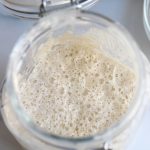
Easy Sourdough Starter
Ingredients
- 700 grams white all-purpose flour *see Note #1 below
- 700 grams filtered water
Instructions
Day 1
- In a medium sized glass bowl mix together 50 grams of water and 50 grams of flour. Stir well and cover. Let sit at room temperature.See Note #2 and Note #3 below.
Day 2
- To yesterday’s mixture add 50 grams of flour and 50 grams of water. Stir well and cover. Let sit at room temperature.
Day 3
- Throw away half of the Starter. To the remaining Starter add 100 grams of flour and 100 grams of water. Stir well and cover. Let sit at room temperature.See Note #3 below.
Day 4
- Throw away half of the starter. Add 150 grams of flour and 150 grams of water to the bowl and stir well. Cover and let sit at room temperature. See Note #4 below.
Day 5
- Similar to the previous days, throw away half of the Starter and add 150 grams of flour and 150 grams of water. Stir well, cover and let sit at room temperature. See Note #5 below.
Day 6
- Throw away half of the starter and add 200 grams of flour and 200 grams of water. Stir well, cover and let sit at room temperature. See Note #6 below.
Day 7
- On day 7 the Starter should at the least look like photo B above if not like photo C. If it has a similar appearance to photo C, it is ready to use. If it looks like photo B, let it sit at room temperature for one additional day.


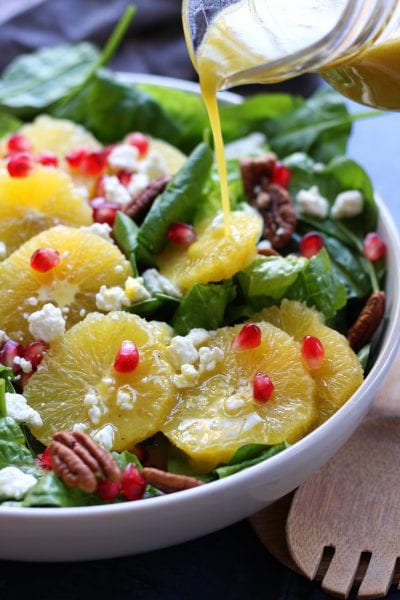
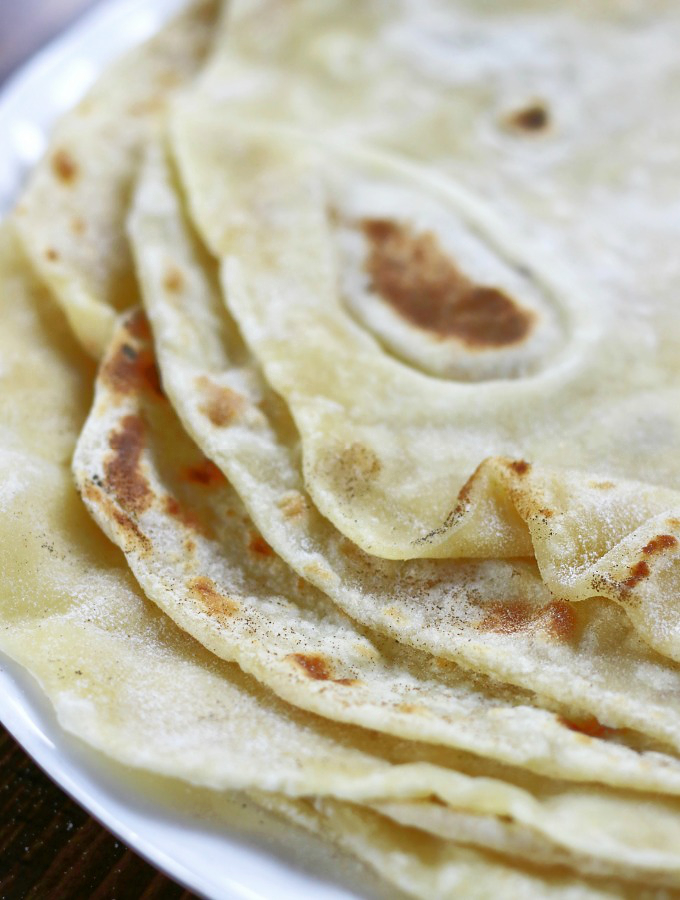
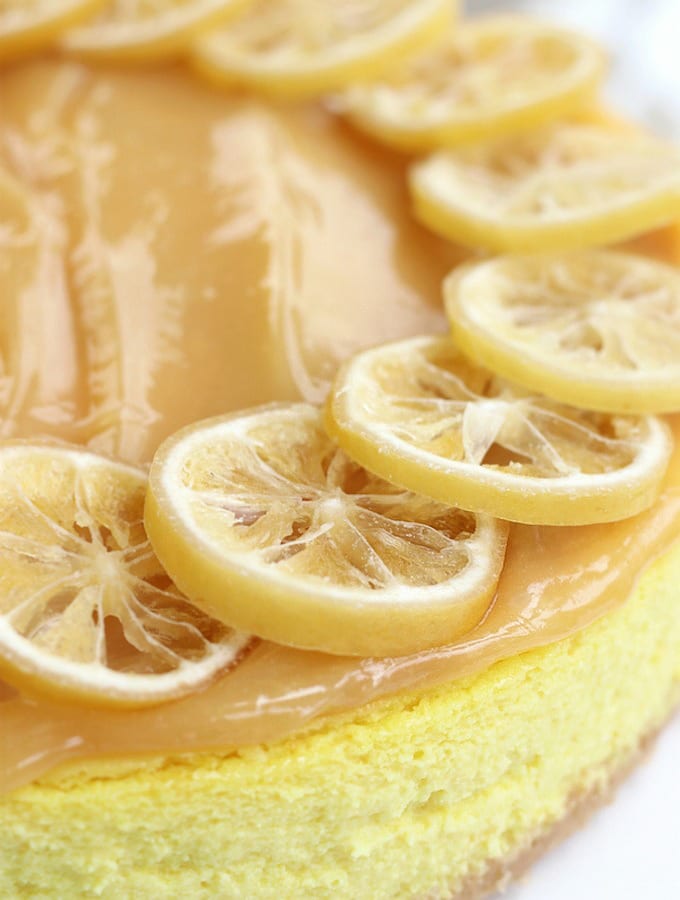


Hi, I am a newbie to sourdough and saw your recipe and thought I would try it. I didn’t realize that I shouldn’t have used a tight lid through the process. I am now on day 7 and its watery consistency. Can I use what I have and loosely cover for a few days? Or for good results will I need to start over? It does smell a little sour. Thanks for the help!
Hi Brandy! Welcome to the sourdough journey. No worries about the tight lid, it’s a common hiccup for people in the beginning. The watery consistency you’re seeing is hooch, which is just a natural byproduct of fermentation and a sign your starter is hungry. You can definitely try saving it!
Here’s what I’d recommend:
1) Stir the hooch back into the starter.
2) Feed it 150 grams of both flour and water.
3) Loosely cover it with plastic wrap or paper towels and a rubber band. This will allow it to breathe while keeping dust out.
4) Discard half the following day and feed again. Repeat this process until your starter is full of life. You’re looking for bubbles and a thicker consistency. If it starts looking active and bubbly again, you’re good to go!
If it doesn’t perk up, starting over might give you more reliable results, but I have a good feeling about this one. I hope this helps, and don’t hesitate to reach out if you have more questions!
I just did the same thing! Thank you for asking this question 🙂
Hi Kelley. Thank you so much for checking out the comments. I hope my response to Brandy is helpful for you. Don’t hesitate to reach out with any questions.
hi, hoping for some help 🙂 I’m on day 7 but if I’m honest my starter looks closer to picture A with a slight appearance of picture b? do I have to start over? do I just keep feeding everyday until it does look like picture b and c??? and if so how much 150g?
thank you for any help you can give!
Hi Krystin! No need to start over—what you’re describing sounds totally normal. Sometimes starters take a little extra time to fully develop that bubbly, airy texture like in picture C, but you’re on the right track!
Once you hit day 7 go ahead and discard half and feed it 150 grams of both water and flour. Watch for signs of progress, like more bubbles or a slightly tangy smell. If it seems sluggish, you can try placing it in a slightly warmer spot (around 75–80°F is ideal). Also, if you’ve been using the same type of flour, switching to whole wheat or rye for one or two feedings can give it a boost!
I’m guessing it will take 2-3 additional days. I hope this helps but please let me know if you have any questions. Oh, one last thing. You may find this post about maintaining your starter helpful. https://www.thefedupfoodie.com/how-to-maintain-sourdough-starter/
Hi I’m starting a sourdough starter and wanted to know how often you feed it. Does it need to be 24 hours, 12 hours, etc., and does it change with the days on how often it’s fed? Thanks!
Hi Lily! Great question and I’m excited you’re starting your sourdough journey! In the beginning, the starter only needs to be fed once a day, and it doesn’t have to be a perfect 24 hours between feedings. Just aim for around the same time each day, and it’ll be happy.
Once your starter is developed and thriving, the feeding schedule can vary based on how often you bake, the temperature in your kitchen, and whether you store it on the counter or in the fridge. For more detailed tips on maintaining your starter long-term, my post “How to Maintain Sourdough Starter” dives into everything you’ll need to know. I hope that helps, and happy baking! https://www.thefedupfoodie.com/how-to-maintain-sourdough-starter/
Hi Heather,
My starter is on day and smells rank, is this normal?
Hi Vicki,
It’s not uncommon for a sourdough starter to go through a funky phase, especially around day 2 or 3. That “rank” smell is likely the byproduct of wild yeast and bacteria settling in. Let’s dig a little deeper into what you’re experiencing:
1) Alcoholic smell – A sharp, almost nail-polish-remover scent caused by fermentation.
2) Sour or tangy odor – A natural part of developing lactic acid bacteria.
3) Rotten or putrid – This could signal an issue, like contamination or improper feeding.
If it’s closer to option 1 or 2, your starter is likely on track! If it smells more like option 3, I’d recommend starting fresh to ensure the best results. Let me know if you need more help! 😊
I am about to start my very first sour dough starter and after reading the comments I guess I’m not to use the container that is pictured! But, I am unsure if I’m to cover it with siran wrap or something else. Can you advise me? oh and thank you for the trouble shooting other people’s starters, it’s a big help to watch out for.
How exciting to start your first sourdough adventure! You’re right, the container doesn’t have to match the picture. Any clean container works as long as it’s roomy enough for your starter to grow. You can cover it loosely with plastic wrap, a clean kitchen towel, or even a paper towel secured with a rubber band (those from a broccoli bunch work perfectly!). I’m so glad the troubleshooting tips have been helpful. Wishing you lots of bubbly success!
I can’t wait to get started! If I start with wheat or rye flour to get the “more sour” sour dough, when making bread, would I use white flour as normal, or do I need to use wheat or rye? Thank you!!
Hi Sharnee! I am so excited for you! You are going to love making homemade sourdough! Starting with wheat or rye flour is a great choice for a tangier sourdough flavor. Just keep in mind that these flours absorb more water, so you might need to add a touch more water to keep your starter at the right consistency—thick but stirrable. When making bread, you can use white flour as normal, or stick with wheat, rye, or even a combination. And if you want, you can switch your starter over to all-purpose or a mix later on. Have fun experimenting!
Hi there, this is my very first time starting my sour dough journey and I am just in my second day but I am already noticing that my starter is already starting to bubble up is this normal?
Hi Yanna. That’s wonderful to hear! Yes, bubbling on day two is completely normal and a great sign that the natural yeast and bacteria are becoming active. It’s common for this early activity to slow down over the next few days as the microbes find their balance. Don’t worry if it seems less bubbly for a bit, just stick to the feeding schedule and it will pick back up as it strengthens!
Hi there I just started my starter yesterday and I fed it(as instructed for day2) today and checked on it after a few hours maybe 5-6 hours after I fed it and it’s already doubled its size and looking more like picture B. Is this normal?
Hi Tyler. That’s great progress! It sounds like your starter might be experiencing a “false rise”, which is normal in the early days as the yeast and bacteria are still developing. After a false rise, it may deflate or settle down as the initial gases dissipate. This is all part of the process. Just stick to the feeding schedule, and you’ll see it stabilize and grow stronger over the next few days. Also, don’t hesitate to reach out with nay questions along the way.
Hello. I am on day 8, and my starter still doesn’t have a sour smell. It just smells like flour. Did I do something wrong??
Hi Charity! Thanks for reaching out. It’s completely normal for the starter to still smell mild at this stage. It can take some time for the tangy, sour aroma to fully develop. To better help, could you let me know if your starter is bubbly and rising after feedings? These are key signs that it’s active and on the right track. Let me know, and we’ll figure this out together
Hi Heather, thanks for the response. Yes, it is bubbly and rising. Just didn’t smell sour at all.
Oh good! You should be good to go for using it in recipes. As your starter matures, you will start to notice more and more of the tangy smell and flavor forming. I would love to hear how it goes so please keep me updated. Happy baking!
i haven’t started it yet, but I bought bread flour because I read somewhere that it was better…is that true?
Hi Sue! Great question! Bread flour can work well for a sourdough starter because its higher protein content may promote strong fermentation. I use all-purpose flour because it’s versatile and works beautifully. Rye and whole wheat flour are also fantastic options, especially in the early stages, as they ferment more actively. Just remember that wheat and rye flours absorb more water, so you might need to adjust by adding a bit more water for the right consistency. Bottom line, you have plenty of great options to get wonderful results. Happy starting!
Hi! I just started my sourdough and I am on day three but I accidentally fed 100grams of flour and water instead of 50. Do I just continue as directed even though I have too much on day two? Let me know thank you this has been such a fun process so far!
Hi Pyper! There is no problem at all. Adding a bit more flour and water is completely fine and won’t harm your starter. This might just mean the feeding process may take 1-2 more days before being ready to bake with, but all should be fine. That makes me so happy to hear you’re enjoying the process. Sourdough is the best!! Happy baking and don’t hesitate to reach out if any questions pop up.
If half of the starter works for making bread, why doesn’t the other half? Meaning, why can’t I separate the amounts in two like you suggest and then follow the steps to keep feeding so that you have multiple loaves?
Hi Stephanie! Great question! You can absolutely separate the starter into two portions if you’d like, but there are a couple of things to keep in mind. Each portion would then need its own regular feeding schedule to stay active and healthy, which can add up quickly in terms of flour and time.
Since half the starter already makes enough for two large 2-pound loaves, most people find it more practical to keep just one starter and scale up the amount they bake as needed. If you’re baking very frequently, keeping multiple starters could work, but for occasional baking, it’s easier to stick with one.
I hope this helps clarify things! Let me know if you have any other questions.
I’m so excited to start my first starter! When it’s ready to be used in baking and I only use say half of the starter, di keep feeding the rest of the starter or just keep it in the fridge until I’m ready to use the rest?
Thank you!
Hi Baily! How exciting that you’re starting your first sourdough journey! 🥳 Once your starter is bubbly and active, you can absolutely store the remaining starter in the fridge if you’re not planning to bake right away. While it’s young (under six months), I recommend feeding it about three times a week to keep it strong and healthy. As it matures, you can stretch the time between feedings.
Just a quick note—if you’re planning to bake, make sure to feed it daily at room temperature until it’s bubbly and active. I also have a post called ‘Maintaining Sourdough Starter’ that shares all the tips and tricks to help you along the way. I hope you love baking with your starter and please don’t hesitate to reach out with any questions. I would love to hear how it goes! https://www.thefedupfoodie.com/how-to-maintain-sourdough-starter/
What to do when sourdough is ready to bake with. How to prepare for
The baking where is a recipe
Hi Reva! You can find my sourdough recipes by on the “Recipes” tab at the top of my home page and then the sourdough section. The are also organized under breads.
Hi! It’s day 7 and my starter is between B and C…do I feed it again or just wait til it gets more bubbly?
Hi Nichole! If your starter is between B and C, I recommend continuing the discard and feed process daily until it reaches the bubbly, active look of picture C. Sometimes it just needs a day or two more to fully develop. You’re getting close!
Hi, first time doing sourdough. I fed mine last night at 5:30. When I got up this morning it looks like it did rise just about double but when I looked this morning it looks like it deflated some. It does have that nice tangy smell to it. Do you think it’s ready to bake with and if yes do I just take out what I need and then feed the rest again today?
Hi Eileen! It’s exciting that you’re diving into sourdough! The tangy smell and the rise you’re seeing are great signs, but the timing here is important. If you’re still within the first 7 days of starting your sourdough journey, I recommend continuing with the regular discarding and feeding until at least day 7. Early on, it’s common to see a rise and deflation that might look promising, but it could be a “false rise” as the natural yeast and bacteria are still establishing themselves.
If you’re past day 7 and your starter is consistently doubling within 4–6 hours of feeding, you’re likely ready to bake! To use it, just take out the amount your recipe calls for and feed the remaining starter with equal parts flour and water by weight.
If you’re unsure or want to confirm it’s ready, you can try the “float test”: take a small spoonful of starter and drop it into a glass of water. If it floats, it’s good to go! If it sinks, give it a little more time to mature.
I hope this clears things up, and feel free to share what day you’re on if you’d like more specific advice. Happy baking!
Hi! I’m on my 6th day and my dough is not smelling like sourdough, so why is that? What do I need to do?
Hi Cathy! You’re doing great. It’s completely normal for a brand-new starter to take a little time to develop that signature sourdough smell. On day 6, your starter is still in its early stages of maturing, and that tangy aroma may take a few more weeks to fully develop.
How is your starter looking? Is it bubbly and showing some rise after you discard and feed it? These are key signs that it’s on the right track, even if the smell hasn’t fully come through yet. If it’s not very active, keeping it in a warm spot (around 75–78°F) can really help.
Consistency is key. Keep up with the daily discards and feedings, and over time, your starter will gain strength and develop more complex flavors and aromas. Sometimes it’s just a matter of time, but you’re definitely on the right path.
I hope this helps! Let me know how it’s looking, and I’d be happy to help with more tips if needed.
Once I reach day 7 on my starter, and it looks like picture C, can I put the lid on the jar? I did a whole wheat in a mason jar, and put the lid on loosely. I also did an all-purpose in a jar with a lid similar to the one you used for all purpose flour in the recipe, can I close the lid until I am ready for use?
Hi Mel! Great question, and I’m glad to hear your starter is coming along! While you’re still actively feeding your starter, it’s best to cover the jar with a paper towel secured with a rubber band or plastic wrap instead of a lid. This allows the natural gases from fermentation to escape easily and keeps everything safe and clean.
If you’re taking a break from feeding and storing the starter in the fridge (or on your countertop) for a longer period, you can put the lid on loosely. Once you’re ready to start feeding again, remove the lid and go back to using a breathable cover. This helps maintain the starter’s activity and ensures it stays healthy.
I hope this helps, and happy baking! Let me know if you have more questions.
Hi at what point can I give part of my starter away but still have some to bake with?
Hi Christy and great question! You can share part of your starter once it’s active, bubbly, and strong—usually around day 7 or later, depending on how it’s progressing. Just make sure you have enough left to continue feeding for your own baking needs. A good rule of thumb is to feed your starter first, then split it after it’s risen and is at its peak activity.
To help the lucky recipient keep their starter active and thriving, you might want to point them to my post, How to Maintain Sourdough Starter. It’s full of tips to make caring for a starter easy and stress-free. I hope this helps, and happy baking to you both! https://www.thefedupfoodie.com/how-to-maintain-sourdough-starter/
IM FAMILIAR WITH SOURDOUGH STARTER. MY QUESTION IS CAN I START A SECOND FROM THE FIRST JAR THEN ADD THE DISCARD FROM THE FIRST JAR TO THE SECOND JAR BECAUSE IM ONLY DOING 36 G FEED THAT ONCE A WEEK, THEN WHEN I HAVE 2 TO 3 CUPS MAKE MY RECIPES WITH IT? HOPE ITS NOT A CONFUSING QUESTION.
Not a confusing question at all! Yes, you can absolutely start a second jar by using the discard from your first starter. Just treat it like a new starter—feed it with equal parts flour and water (by weight) until it becomes active. For your main starter, feeding only 36g weekly works well if you don’t bake often, but keep in mind you’ll eventually need to discard some to maintain the right ratio of starter to fresh flour and water. I hope that helps!
Hi! I’m using your method for my starter but using rye flour (50g rye/50g water), and my day 1 mix looks quite dry. I saw in your notes that rye may need some more water, should I wait until tomorrow (day 2) to add a bit more or should I add some now? Thanks in advance 🙂
Hi Carleigh! I’m so sorry for the delay in getting back to you. If your Day 1 mix looked dry, it’s completely fine. You can adjust by adding a little extra water during your Day 2 feeding to achieve that thick but stirrable consistency. Rye flour tends to absorb more water, so this is totally normal. Rye flour can make for such a lively starter, so you’re off to a great start. I hope this helps!